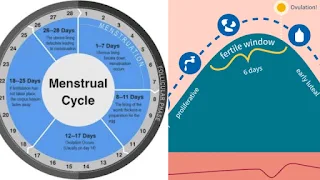OVULATION AND MENSTRUAL CYCLE OFTEN CALLED PERIOD
Menstruation is a woman's month normal vaginal bleeding often called the period.
When a baby girl is born, her ovaries contain hundreds of eggs, which stay inactive until puberty begin, there isn't one right age for a girl to get her period but Most gils get their first period about two years after their breasts start to develop.
When they're between age 10 and 15 but it's different, every girl's body has its own schedule two structures in the brain, the pituitary gland and the hypothalamus produce complex hormones start and control the menstrual cycle.
And it will continue to about age 51 usually lasting from three to 8 days the menstrual cycle includes several phases, the first phase of the menstrual cycle begins on the first day of bleeding and lasts for about 14 days.
The pituitary gland (Located at the base of the brain) Releases a hormone called FSH. This hormone causes one fluid -fillled '' follicles contain a mature egg to develop. The maturing follicle produces the hormone called oestrogen.
Which increases over and peaks in about day 12 and causes the lining of the uterus (endometrium) to become thinker and more enriched with blood vessels.
In fact the women's body prepares to get pregnant On about day 14, the high amount of LH and FSH cause he eddoes to be released from the follicle, the high level of LH also causes a brief surge in testosterone, which increases sex drive, right at the most fertile time of the cycle after release, the egg enters the Fallopian tube tiny hairs in the tube's lining help push it down the narrow passageway toward the uterus.
If the sperm cell can successfully meet an egg cell in the Fallopian tube, the fertilisation will take place, once the egg is released, the follicle seals over and this is called the corpus luteum.
After the release of the egg, levels of FSH and LH decrease the corpus luteum products progesterone if fertilisation has occurred, the corpus luteum
continues to produce progesterone which prevents the endometrial lining from being shed. If the egg is not fertilised, it disintegrates after about 24 hours then the corpus luteum also disintegrates which causes progesterone levels to drop and signals the endometrial lining to begin shedding after about 14 days.
The menstrual blood is party blood and party tissue from inside the uterus. It passes out of the body through the vagina the period comes again every 24-38 days from the first day of one period to the first day of the next.
Besides bleeding from the vagina, you may have abdominal or pelvic cramping pain lower back pain headache fatigue Mood swings and irritability Food Cravings Bloating and sore breasts.







0 Comments